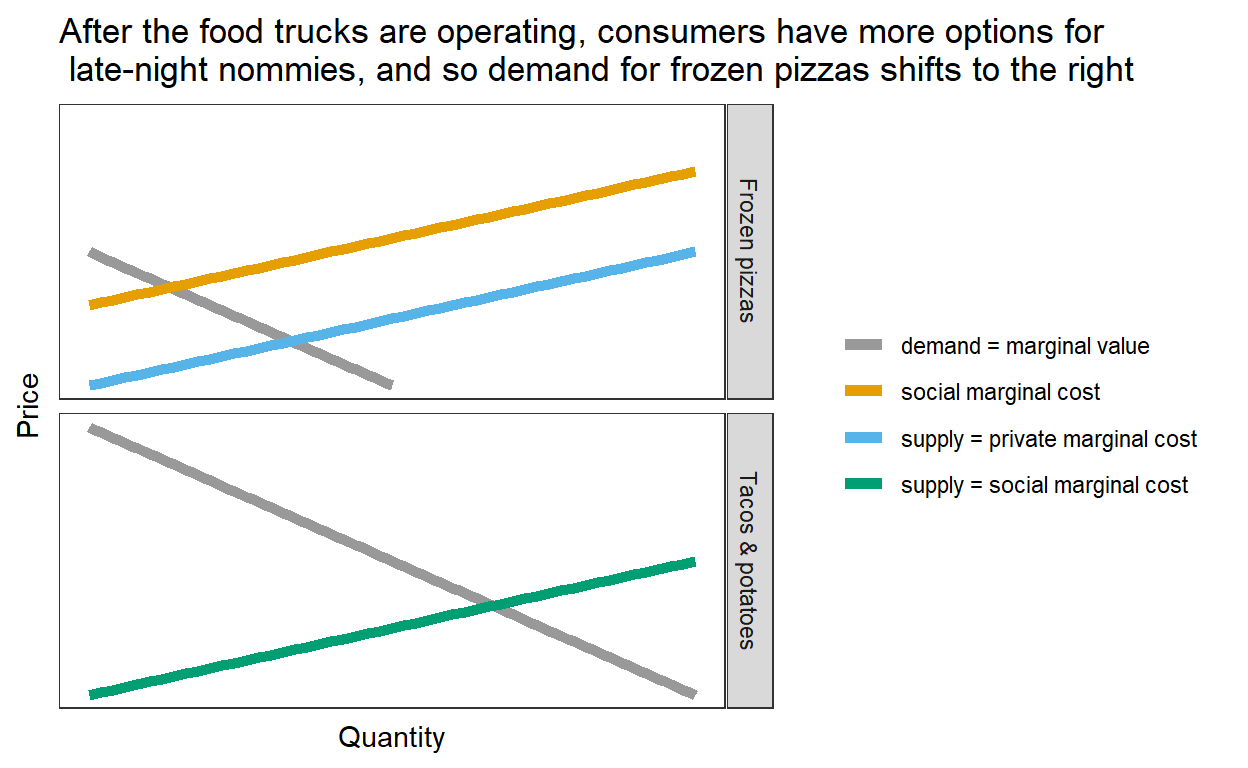Over spring break, I had the pleasure of visiting my sister, Emma Bland in Longyearbyen, Svalbard. As much as this trip was supposed to be about catching up with my sister, and messing with the all sky camera at the observatory:
My sister does stuff with radar at the north pole. She also knows when* the all sky camera at the observatory is taking photos
— James Bland (@JamesBland_Econ) March 10, 2020
* it's every 20 seconds, so this was not that hard pic.twitter.com/WsrB7BJcc8
I couldn’t help nerding out with this little story about negative externalities, and a solution to the problem involving street food.
Pre-2019 Longyearbyen
Longyearbyen is a town in the high Arctic. Historically, it has had strategic and coal-mining roots, but this has mostly given way to tourism and research. Temperatures are often way below freezing, and if one is leaving town, one has to take a rifle with them in case there is a polar bear. My sister, Dr. Emma Bland, is a postdoc at the University Center in Svalbard, and when she’s not studying the aurora she spends her time exploring nearby mountains, glaciers, and ice caves by foot, skis, and snowmobile.
Despite its remote location, the tourism industry ensures that Longyearbyen has a vibrant restaurant and bar scene. As such, it is not uncommon for people to be walking home from a merry evening on the town in the wee hours of the morning. What does one frequently crave after a walk home from the pub? Well, this can be somewhat location-dependent. For example, in my hometown of Melbourne, it is traditional to satisfy one’s late-night cravings with a kebab:
However, it turns out that less-than-sober Norwegians’ tastes are more geared towards “Italian” food, so the aforementioned ambulations to one’s domicile are more likely accompanied by a pizza. In fact, given that there are no pizza places open during customary post-drinking times, these pizzas are most likely frozen pizzas, cooked in the comfort of one’s own home.
This is where things start to become a bit dangerous. A frozen pizza takes some time to cook, and since our merry protagonist is getting a bit drowsy by this point in the evening, it is not uncommon for people to fall asleep before the pizza is ready, and then get woken up by the fire department when the pizza is a bit on the well-done side of charred and smoking.
Fire is a very serious issue for Longyearbyen. Most people live in closely-spaced wooden apartments, so the consequences of a fire are rarely isolated to one home. Additionally, smoke detectors automatically call the fire department, and so these activities not only put quite a few people in danger, but are also a drain on emergency responders’ resources.
Let’s have a think about this from a Principles of Microeconomics standpoint. Consumption of frozen pizzas in Longyearbyen imposes a negative externality on our late-night chef’s neighbors. Hence, the supply curve does not measure the full social marginal cost of the good:

Therefore, frozen pizza consumption is too high: since consumers and producers do not bear the entire cost of frozen pizzas, the market encourages too much late-night pizza cooking from society’s standpoint.
A more usual Principles of Micro solution to this would be to impose a tax on frozen pizzas, which makes consumers pay the full social cost of their activities. However, sometimes by happy accident (or unhappy accident, if we’re talking about Jurassic Park), life finds a way.
A partial fix
This all changed in 2019, when a potato stand opened up in downtown Lonyearbyen. This stand is currently open between 10pm and 4am, Friday-Sunday. So people are much less likely to be hungry when they get home from the pub. In addition to this, there is also a taco truck open Wednesday-Saturday fulfilling this need. Tacos and potatoes are substitutes for frozen pizzas, so having these food trucks available late at night means that demand for frozen pizzas has shifted to the left, and the fire department’s dreaded “Tørrkoking” (“dry cooking”) callouts are on the way down.

As the local English-language newspaper puts it:
Kjelleberg’s [potato] truck– and therefore likely Styrsell’s [taco truck] – is satisfying more than just people looking for something different – or anything at all in the wee-morning hours when pubs close and all other eateries are closed. The Longyearbyen Fire Department praised Kjelleberg for providing such an option because it reduced the likelihood of intoxicated people igniting “dry cooking” fires by falling asleep while trying to cook food at home, which the department has called its top threat the past several years.
While there really aren’t enough years to do a propper analysis with (say) synthetic controls, it looks like these food trucks are bringing more than just tasty food to the community.

To paraphrase Adam Smith:
It is not from the benevolence of the potato vendor or the taco truck owner, that we expect to safely satisfy our late-night cravings, but from their regard to their own interest. We address ourselves, not to their humanity but to their self-love, and never talk to them of our own necessities but of their advantages.